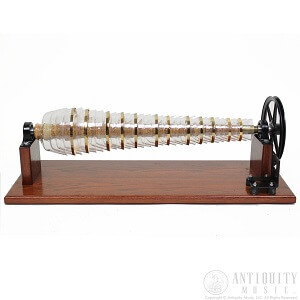Glass Harmonica
 The glass armonica was one of the most celebrated instruments of the 18th century. Franklin began to take his beloved armonica with him when he traveled and played popular Scottish tunes or original compositions for his audiences. Later, composers such as Beethoven, Mozart, and Donizetti would write music for the armonica. Because of its almost immediate popularity, the glass armonica seemed destined for permanence. But by the 1820s, it was nearly a forgotten instrument.
The glass armonica was one of the most celebrated instruments of the 18th century. Franklin began to take his beloved armonica with him when he traveled and played popular Scottish tunes or original compositions for his audiences. Later, composers such as Beethoven, Mozart, and Donizetti would write music for the armonica. Because of its almost immediate popularity, the glass armonica seemed destined for permanence. But by the 1820s, it was nearly a forgotten instrument.
Over the years, some disturbing events began to be associated with the glass armonica. Some armonica players became ill and had to stop playing the instrument. They complained of muscle spasms, nervousness, cramps, and dizziness. A few listeners were also subject to ill effects; after an incident in Germany where a child died during a performance, the armonica was actually banned in a few towns. Some people thought that the high-pitched, ethereal tones invoked the spirits of the dead, had magical powers, or drove listeners mad.
Others thought that lead from the crystal bowls or paint was absorbed into the musicians' fingers when they touched the glass, causing sickness. No explanation or proof was ever really given to any of these claims. Franklin himself ignored all of the controversy and continued to play the instrument until the end of his life with none of the symptoms mentioned. But the armonica's popularity never really returned to what it had been when it was first introduced.